Playing CBT – Therapy Games that Teach Emotional Regulation
What’s inside this article: An overview of the components of emotional regulation and 15 games based on cognitive behavioral therapy (traditionally a talk-based therapy) to help teach emotional regulation to children.
Disclaimer: This post contains affiliate links.
Emotional regulation is the ability to understand, manage, and respond to an emotional experience in an appropriate way.
There are several components to effective emotional regulation, and this is a skill some kids really struggle with. Therapy games are one way to help struggling children develop emotional regulation.
Components of Emotional Regulation
Emotional regulation is an executive functioning skill, which is something I cover a lot. Executive functioning occurs in the brain’s prefrontal cortex region – this region isn’t fully developed until the mid-twenties.
That means emotional regulation can be hard for all children. However, some children, such as those with ADHD or autism, may struggle significantly with this skill.
There are a few components of emotional regulation, and to be successful, you need to learn them all. These components are:
- Identifying emotions – Your child needs to know what they’re feeling.
- Expressing and understanding emotions – They need to understand why they feel that way and have some means of expressing that.
- Responding to (rather than reacting to) emotions – The response should match the size of the problem. For example, dropping their pencil is a minor blip that may be slightly frustrating but shouldn’t have a big emotional response. A loved one getting into a car accident, on the other hand, is a much bigger problem and a larger emotional response would be expected.
- Using healthy strategies to manage emotions and calm down – There are physiological changes in our bodies when we’re distressed. Things like increased heart rate, feeling nauseous, sweaty palms. Getting our bodies calm and back to their regulate state plays a huge role in regulating emotions.
If one of these things is missing, your child will no be able to regulate their emotions.
Does your child need to work on any (or perhaps all) of these skills?
Developing Emotional Regulation
For many children, emotional regulation will develop as they get older and their brain develops. It will also develop through many co-regulation experiences with their caregivers.
However, it doesn’t come naturally to everyone. Just like some kids struggle with math or reading, they can also struggle with emotional regulation.
For those children, different teaching strategies, interventions, and therapies may be necessary. Social-emotional learning programs like the Zones of Regulation and Superflex can help.
Another useful intervention is cognitive behavior therapy or CBT for short.
Cognitive Behavior Therapy
CBT is a talk-based therapy that is helpful for all age groups. CBT can help kids:
But here is where the problem lies.
It can be really hard for a child to sit through a talk-based therapy session and engage with their therapist, especially if they struggle with social-emotional skills.
Anything play-based is more likely to be successful for a child. That’s what PlayingCBT is for.
Playing CBT
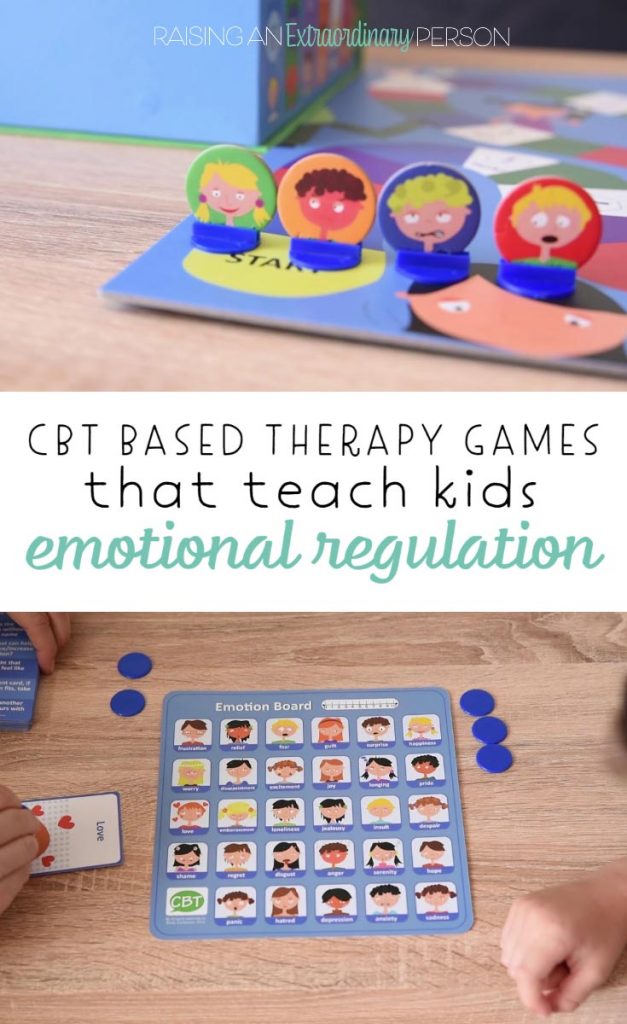
Playing CBT consists of 15 therapy games for kids, all in one box. It’s designed to help them with emotional regulation, self-awareness, self-control, coping skills, and social-emotional skills.
It’s available for purchase on Amazon here.
You can adapt games to make them suitable for different age groups. There are also some blank cards you can use to tailor the games to the child’s individual situation.
I had the opportunity to try Playing CBT at home with my oldest. This was great because he has self-proclaimed to “hate feelings,” and emotional regulation is his biggest struggle.
He’s been playing and stays engaged in the games with me; although he will sometimes say they’re “too hard,” I think it’s good to challenge him a little. I can help him through the difficult parts by sharing my own thoughts and experiences.
I’ve learned that he understands more than he’s willing to communicate openly, so it’s still valuable to use these games when participation from him is minimal.
What’s In The Box?
The box contains a detailed booklet with complete instructions on using all the items in the kit.
The box contains:
- Beginners’ game board (stage 1): learning to identify events, thoughts, feelings, and behaviors.
- Advanced game board (stage 2): learning to identify events, thoughts, emotions, behavior, coping thoughts, and physical sensations.
- Emotion board – to identify emotions, and a scale from 0 to 10 to measure their intensity.
- Physical sensations board – to identify physical sensations and understand the connection between sensations and emotions (with the help of the emotions cards – see below).
- Event cards (green) – to facilitate talking about events from the child’s everyday life.
- Negative thought cards (red) – to understand and identify automatic thoughts that are ineffective.
- Coping thought cards (light blue) – to facilitate the development of flexible thinking.
- Emotions cards (blue) – to display “pleasant” and “unpleasant” emotions, with a scale to measure the intensity of these emotions from 0 to 10 and associate them with thoughts and behavior.
- Physical sensation cards (orange) – to identify physical sensations and associate them with emotional experiences.
- Behavior cards (purple) – to distinguish between effective behaviors for the long-term (adaptive) and emotion-driven behaviors that are only effective for the short term.
- A strip of thinking traps – a list of 10 cognitive distortions based on the cognitive-behavioral model used to identify the automatic thoughts that correlate with these thinking traps.
- Rethink cards (yellow) – questions that allow players to refute automatic (negative) thoughts that arise for each corresponding thinking trap.
- Task cards (green) – social situations.
- Blank cards – cards that allow children to add their own personal experiences using a whiteboard marker (included).
- Emos – pawns with faces displaying emotions.
- Tokens – 60 tokens.
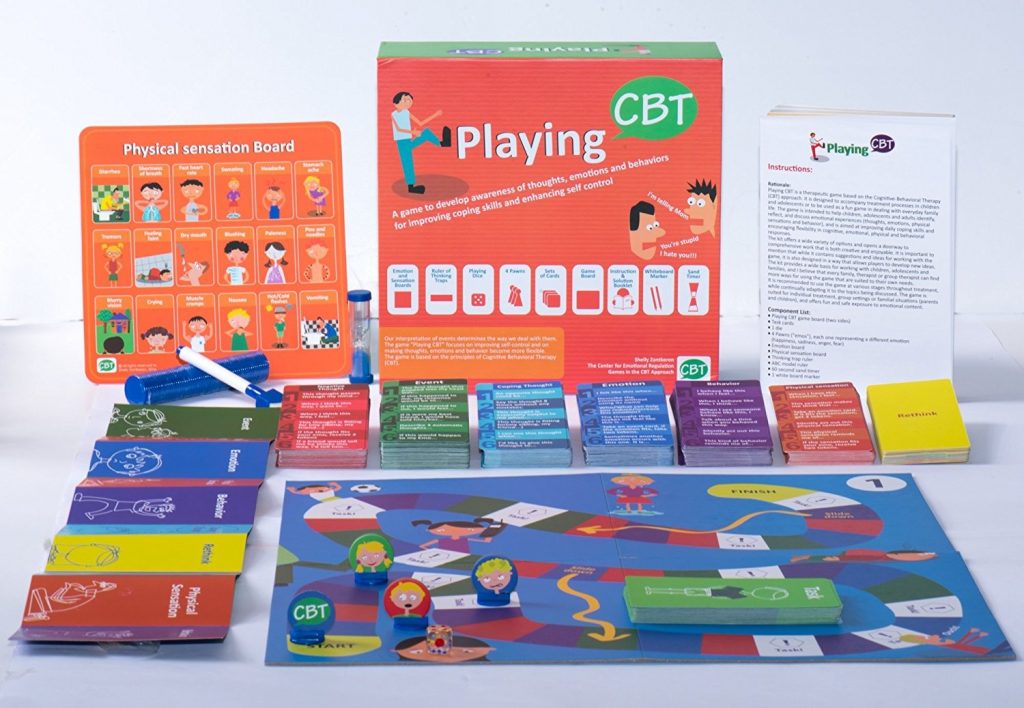
What Therapy Games Can You Play
There is a lot of stuff in the box and a lot of possible therapy games to play with the stuff. Thankfully, the booklet includes instructions for all the games.
You can also modify games for simplicity if you’re playing with younger children or use the blank cards and dry erase marker to make your own individualized cards.
Here’s a list of included therapy games:
- Emotion Bingo
- Mixing Emotions
- Identifying Others’ Emotions
- The Emotion Sculpture
- Associating Emotions and Physical Sensations
- Emotion/Event matching
- Negative thought/Coping thought matching
- One the one hand/On the other hand
- Quartets
- The Mindreader
- On Second Thought
- The Chain of Behavioral Reactions
- The Chain of Parental Reactions
- Speed CBT
- Positive Narrative/Negative Narrative
Therapy Games Examples:
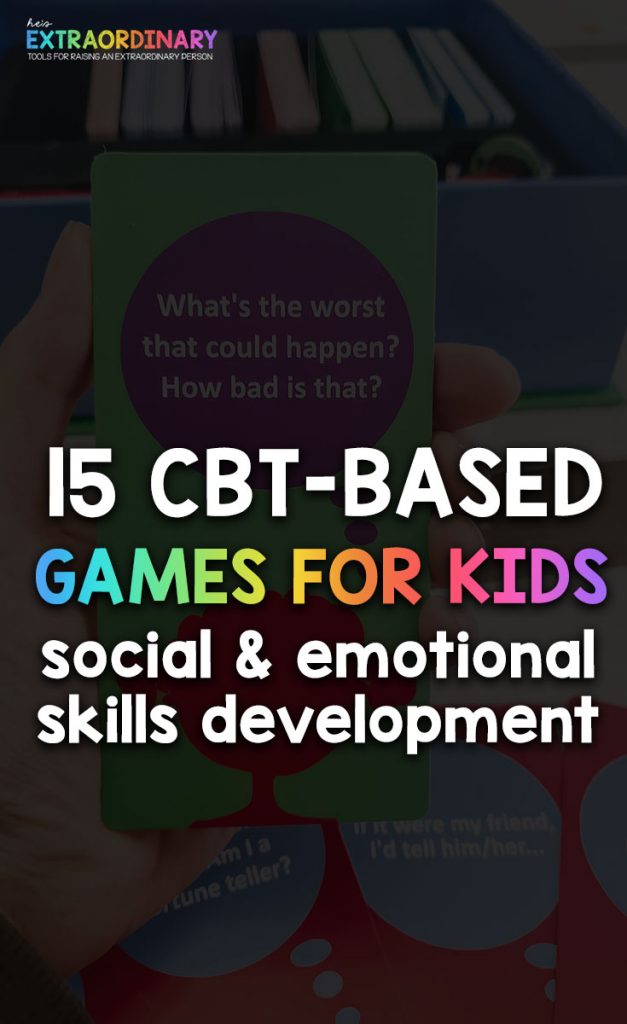
Negative Thought/Coping Thought
Lay the negative thought cards (red) in rows on the table. Have your child go through the deck of “coping thoughts” and match thoughts that they think would be good coping thoughts for the corresponding negative thought.
You may want to sort through the deck for beginners and remove any coping thoughts that wouldn’t match any of the negative thoughts you have on the table.
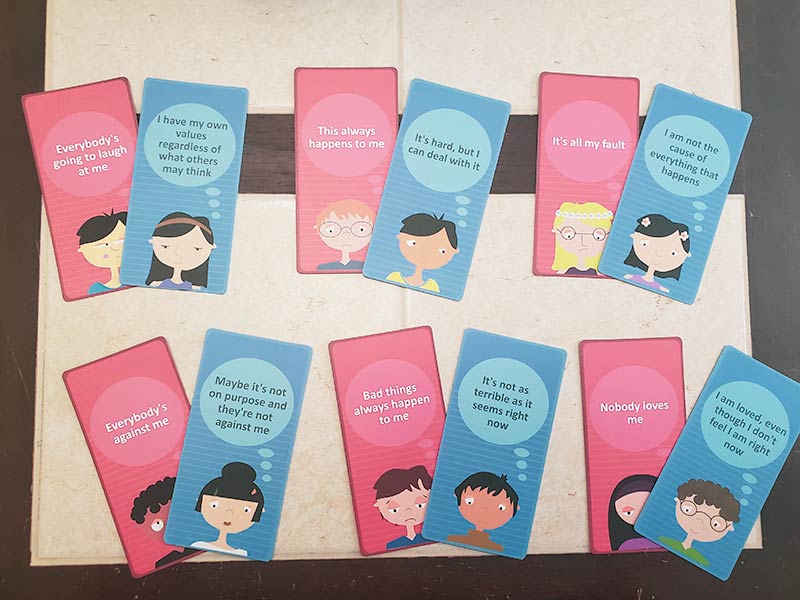
Physical Sensation & Emotion Pairing
Use the physical sensation board, the emotions card, and the red tokens.
Pull an emotion card from the deck and flip it over. Then, look at the physical sensation board and place a red token on each sensation you experience when feeling the emotion on the card.
Example: In the photo below, the card is “Embarrassment,” and the player placed a red token on “sweating,” “dry mouth,” and “blushing”
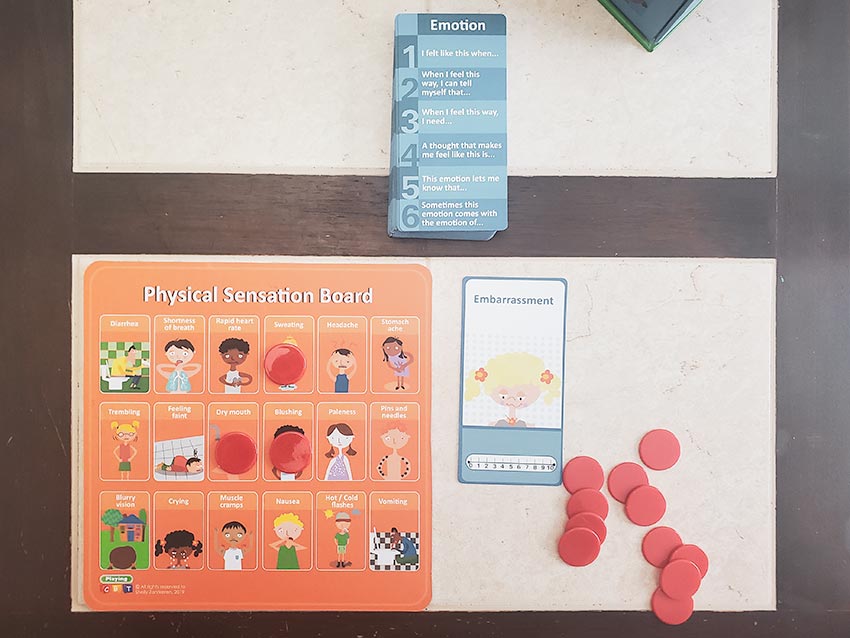
This therapy game will help you determine whether or not your child knows which physical sensations are caused by which emotions – this is necessary for identifying emotions.
Your child will also get better at identifying their emotions by playing this game because they will need to really think about what’s happening in their bodies during different emotional experiences, helping them become more aware.
Relating Emotions to Events
This is played similarly to the emotion and sensation pairing game. Only this time, you’ll use the emotion board and the event cards.
Pull an event card from the deck and read the scenario out loud – you can read it to your child or have them read it.
Then, place a red token on top of each emotion on the emotion board that you may experience if this situation happened to you.

This activity helps kids with perspective-taking since the events are hypothetical situations; you’ll have to imagine how you’d feel.
This also opens up the opportunity to talk about how your behavior impacts others and how other people would feel. For example, how would the teacher feel? How would Dan feel?
If Your Child Struggles to Regulate During Therapy Games
Often, kids struggle to actually maintain emotional regulation when they try to play these types of games. Emotions are a triggering topic for many.
This is a game designed to be played when kids are calm and ready to learn, not when they’re dysregulated.
If your child is dysregulated, don’t push them to continue playing. Instead, focus on co-regulation. You may be able to continue playing after a short break, or it may be necessary to pack it up and try again later.
Children will start developing a tolerance for playing the game. You should find they can regulate and participate more and more as you continue to expose them to the therapy games and keep the experience positive.
If your goal is to teach your child emotional regulation, these resources might also be helpful:
- Zones of Regulation Overview for Parents
- Zones of Regulation Activities
- Free Zones of Regulation Printables
- How to Create a Calming Corner in Your Home

